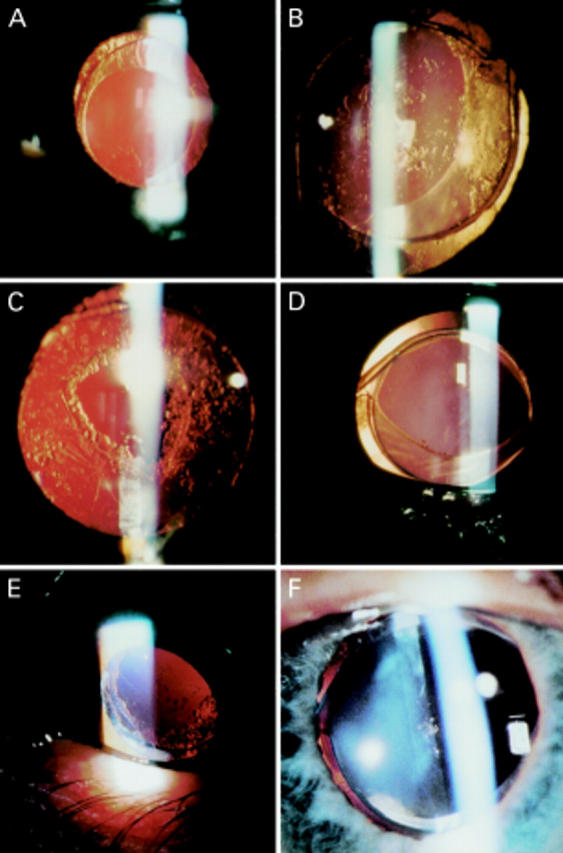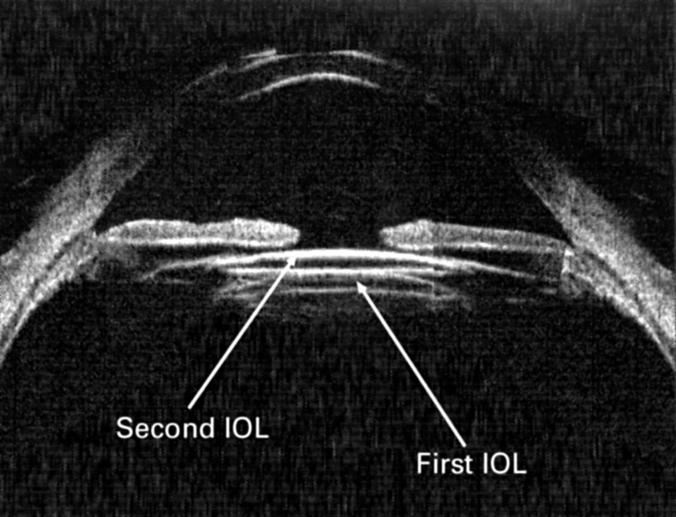Abstract
AIM—To determine the long term visual and refractive results, and stability and complications of primary polypseudophakia using poly(methylmethacrylate) (PMMA) intraocular lenses (IOLs) for cataract surgery in hypermetropic eyes. METHODS—Prospective study of 15 short or hypermetropic eyes undergoing phacoemulsification with primary polypseudophakia with two PMMA IOLs implanted within the capsular bag. RESULTS—The spherical equivalent was reduced from a mean +4.87 (SD 3.00) dioptres (D) to −0.12 (1.40 D), and the deviation from the intended refraction was +0.005 (1.30) D, 23.6 (12.36) months post-implantation. The deviation from intended refraction was not statistically significant (p = 0.989; paired t test). Postoperative best corrected visual acuity (BCVA) was 6/12 or better in all eyes without macular or optic nerve co-morbidity. Interlenticular opacification (ILO) in the form of peripheral Elschnig pearls was seen in four (26.67%) eyes. A new type of ILO in the form of usually pigmented deposits in the central interface developed in five (33.33%) eyes and resulted in the appearance of Newton's rings in three. None of the eyes with ILO had any loss of BCVA or hyperopic shift. Six (40%) eyes were within 1 D from the intended refraction and 14 (93.33%) within 2 D. There was no statistically significant difference in the accuracy of the two intraocular lens calculation formulas used (SRK II and SRK/T). CONCLUSION—Peripheral Elschnig pearl-type ILO can occur as a late complication of primary in the bag implantation of two PMMA IOLs. A new type of ILO is described. Both types of ILO have not to date resulted in deterioration of visual acuity in our cohort. Use of appropriate biometry techniques and IOL calculation formulas may yield more accurate refractive results.
Full Text
The Full Text of this article is available as a PDF (148.4 KB).
Figure 1 .

(A) Slit lamp photograph of case 9 demonstrating mild anterior capsular fibrosis. (B) Slit lamp photograph of case 3 demonstrating posterior capsular thickening. Despite an eccentric anterior capsulorrhexis, the two intraocular lenses remain well centred and the two sets of haptics aligned. (C) Slit lamp photograph of case 1 demonstrating a small YAG laser posterior capsulotomy in an otherwise opacified posterior capsule. (D) Slit lamp photograph of case 14 demonstrating an eccentric anterior capsulorrhexis and well centred optics and parallel haptics. (E) Slit lamp photograph of case 1 showing peripheral interlenticular opacities in the form of Elschnig pearls. (F) Slit lamp photograph of case 15 showing pigmented clumps near the visual axis in the interlenticular space. We have not been able to photograph the associated Newton rings satisfactorily.
Figure 2 .
Montage of ultrasound biomicroscopy of the anterior segment of case 1 showing two intraocular lenses within the capsular bag.
Selected References
These references are in PubMed. This may not be the complete list of references from this article.
- Drexler W., Findl O., Menapace R., Rainer G., Vass C., Hitzenberger C. K., Fercher A. F. Partial coherence interferometry: a novel approach to biometry in cataract surgery. Am J Ophthalmol. 1998 Oct;126(4):524–534. doi: 10.1016/s0002-9394(98)00113-5. [DOI] [PubMed] [Google Scholar]
- Fenzl R. E., Gills J. P., Cherchio M. Refractive and visual outcome of hyperopic cataract cases operated on before and after implementation of the Holladay II formula. Ophthalmology. 1998 Sep;105(9):1759–1764. doi: 10.1016/S0161-6420(98)99050-9. [DOI] [PubMed] [Google Scholar]
- Findl O., Menapace R. Piggyback intraocular lenses. J Cataract Refract Surg. 2000 Mar;26(3):308–309. doi: 10.1016/s0886-3350(00)00351-5. [DOI] [PubMed] [Google Scholar]
- Findl O., Menapace R., Rainer G., Georgopoulos M. Contact zone of piggyback acrylic intraocular lenses. J Cataract Refract Surg. 1999 Jun;25(6):860–862. doi: 10.1016/s0886-3350(99)00031-0. [DOI] [PubMed] [Google Scholar]
- Gayton J. L., Apple D. J., Peng Q., Visessook N., Sanders V., Werner L., Pandey S. K., Escobar-Gomez M., Hoddinott D. S., Van Der Karr M. Interlenticular opacification: clinicopathological correlation of a complication of posterior chamber piggyback intraocular lenses. J Cataract Refract Surg. 2000 Mar;26(3):330–336. doi: 10.1016/s0886-3350(99)00433-2. [DOI] [PubMed] [Google Scholar]
- Gayton J. L., Sanders V. N. Implanting two posterior chamber intraocular lenses in a case of microphthalmos. J Cataract Refract Surg. 1993 Nov;19(6):776–777. doi: 10.1016/s0886-3350(13)80349-5. [DOI] [PubMed] [Google Scholar]
- Gayton J. L., Sanders V., Van der Karr M., Raanan M. G. Piggybacking intraocular implants to correct pseudophakic refractive error. Ophthalmology. 1999 Jan;106(1):56–59. doi: 10.1016/S0161-6420(99)90005-2. [DOI] [PubMed] [Google Scholar]
- Gayton J. L. Secondary implantation of a double intraocular lens after penetrating keratoplasty. J Cataract Refract Surg. 1998 Feb;24(2):281–282. doi: 10.1016/s0886-3350(98)80212-5. [DOI] [PubMed] [Google Scholar]
- Gills J. P., Fenzl R. E. Minus-power intraocular lenses to correct refractive errors in myopic pseudophakia. J Cataract Refract Surg. 1999 Sep;25(9):1205–1208. doi: 10.1016/s0886-3350(99)00163-7. [DOI] [PubMed] [Google Scholar]
- Gills J. P. Piggyback minus-power lens implantation in keratoconus. J Cataract Refract Surg. 1998 Apr;24(4):566–568. doi: 10.1016/s0886-3350(98)80303-9. [DOI] [PubMed] [Google Scholar]
- Holladay J. T., Gills J. P., Leidlein J., Cherchio M. Achieving emmetropia in extremely short eyes with two piggyback posterior chamber intraocular lenses. Ophthalmology. 1996 Jul;103(7):1118–1123. doi: 10.1016/s0161-6420(96)30558-7. [DOI] [PubMed] [Google Scholar]
- Hull C. C., Liu C. S., Sciscio A. Image quality in polypseudophakia for extremely short eyes. Br J Ophthalmol. 1999 Jun;83(6):656–663. doi: 10.1136/bjo.83.6.656. [DOI] [PMC free article] [PubMed] [Google Scholar]
- Kolahdouz-Isfahani A. H., Rostamian K., Wallace D., Salz J. J. Clear lens extraction with intraocular lens implantation for hyperopia. J Refract Surg. 1999 May-Jun;15(3):316–323. doi: 10.3928/1081-597X-19990501-06. [DOI] [PubMed] [Google Scholar]
- Masket S. Piggyback intraocular lens implantation. J Cataract Refract Surg. 1998 Apr;24(4):569–570. doi: 10.1016/s0886-3350(98)80304-0. [DOI] [PubMed] [Google Scholar]
- Mejía L. F. Piggyback posterior chamber multifocal intraocular lenses in anisometropia. J Cataract Refract Surg. 1999 Dec;25(12):1682–1684. doi: 10.1016/s0886-3350(99)00271-0. [DOI] [PubMed] [Google Scholar]
- Mittelviefhaus H. Piggyback intraocular lens with exchangeable optic. J Cataract Refract Surg. 1996 Jul-Aug;22(6):676–681. doi: 10.1016/s0886-3350(96)80301-4. [DOI] [PubMed] [Google Scholar]
- Naeser K., Hjortdal J. O. Bivariate analysis of surgically induced regular astigmatism. Mathematical analysis and graphical display. Ophthalmic Physiol Opt. 1999 Jan;19(1):50–61. [PubMed] [Google Scholar]
- Perrone D. M. Modified intraocular lens power formula in polypseudophakia. J Cataract Refract Surg. 1996 Dec;22(10):1392–1393. doi: 10.1016/s0886-3350(96)80133-7. [DOI] [PubMed] [Google Scholar]
- Shammas H. J. A comparison of immersion and contact techniques for axial length measurement. J Am Intraocul Implant Soc. 1984 Fall;10(4):444–447. doi: 10.1016/s0146-2776(84)80044-0. [DOI] [PubMed] [Google Scholar]
- Shugar J. K., Keeler S. Interpseudophakos intraocular lens surface opacification as a late complication of piggyback acrylic posterior chamber lens implantation. J Cataract Refract Surg. 2000 Mar;26(3):448–455. doi: 10.1016/s0886-3350(99)00399-5. [DOI] [PubMed] [Google Scholar]
- Shugar J. K., Lewis C., Lee A. Implantation of multiple foldable acrylic posterior chamber lenses in the capsular bag for high hyperopia. J Cataract Refract Surg. 1996;22 (Suppl 2):1368–1372. doi: 10.1016/s0886-3350(96)80100-3. [DOI] [PubMed] [Google Scholar]
- Shugar J. K., Schwartz T. Interpseudophakos Elschnig pearls associated with late hyperopic shift: a complication of piggyback posterior chamber intraocular lens implantation. J Cataract Refract Surg. 1999 Jun;25(6):863–867. doi: 10.1016/s0886-3350(99)00034-6. [DOI] [PubMed] [Google Scholar]



